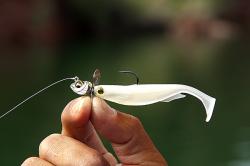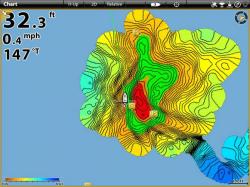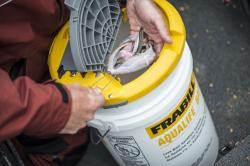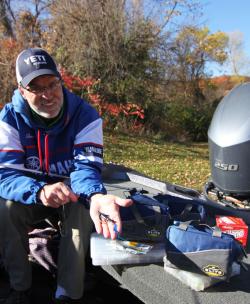Middle Georgia April Bassin’
If you like catching bass in April and live in the central part of Georgia, you are in luck. Bass are shallow and feeding, and you can catch them from big lakes and smaller public waters.
The following lakes give you a variety of types of fishing and offer chances to catch either largemouth or spotted bass, or both.
Lake Harding
Often called Bartletts Ferry by Georgia fishermen, Harding is a 5850 acre lake on the Chattahoochee River north of Columbus. It has varied cover and structure, from rocky banks and points to channels, grass beds, docks and blowdowns that all hold bass.
The lake has a big population of spotted bass as well as largemouth. Most of the spots are small with an average size of only about half a pound, and anglers should keep spots for a meal. There is no size restriction on them. The largemouths have an average size over 12 inches long and 15 inch plus fish are fairly common.
In the Georgia Bass Chapter Federation Creel Census report, it took about four hours to catch a 12 inch keeper, yet almost 20 percent of club tournament fishermen weighed in a five fish limit. The average bass weighed 1.36 pounds and just over 70 percent of the fish weighed in were largemouth.
To catch largemouth in April the water willow grass beds up the river from the Georgia Power ramp are good targets. Bass feed in them as well as bed around them. A spinnerbait run through the grass is a good way to cover water. Use a chartreuse and white bait with one gold and one silver willowleaf blade.
Also fish the grass beds, docks and blowdowns with a weightless worm. A black or white Trick worm works well. Try moving it steadily with short twitches just under the surface, but also let it sink to the bottom and sit still for several seconds before moving it. Bedding bass on the edge of the grass will often pick up a worm sitting on the bottom.
For spots, target rocky points and banks with a small jig and pig or jig head worm. In clear water use a three sixteenths ounce brown jig with a brown twin curly tail trailer. In stained water use a black jig with a blue trailer. Raise the bait off the bottom a few inches and let it fall back, making the tails of the trailer wiggle. Dip the tails of both color trailers in chartreuse JJ’s Magic. Spots love chartreuse.
A green pumpkin Zoom Trick worm or smaller Finesse worm work well on jig heads. Dip the tail to color it and give it scent, and work it with shakes and short hops through the rocks. Also fish both baits around docks, both largemouth and spots will hold on them and hit the worm.
Lake Tobesofkee
Lake Tobesofkee is a 1750 acre lake just outside Macon owned and operated by Bibb County. Although a small lake, it has plenty of structure and cover to fish for largemouth, with grass beds, rocky points and banks, docks, channels and wood cover.
The largemouth population is excellent at Tobesofkee, with 20 pound plus tournament stringers of five bass not unusual. According to the Department of Natural Resources, up to one-third of the catch should be fish in the 15 to 25 inch range with good numbers in the bragging size from 20 to 25 inches.
A spinnerbait or buzzbait worked in the grass and around docks will catch bigger fish. Also try a chartreuse or crawfish crankbait that runs six to eight feet deep on the rocks and docks. Riprap on the bridges hold bass this month to fish it with those baits, too.
For slower fishing try a half ounce jig and pig or three sixteenths ounce jig head worm. A black and blue jig or a green pumpkin worm on a jig head works well. Fish both around dock pilings, brush piles and rocky banks. For riprap go to a one-eight ounce jig head and fish the rocks, concentrating on the corners at the bridges.
The area above the Lower Thomaston Road Bridge has a lot of shallow water but is ringed by good grassbeds to fish. Where the creek enters the lake is a good area to target. The docks and points as well as the riprap on the lower lake offers more varied cover to try.
High Falls
High Falls is a 650 acre lake east of I-75 north of Forsyth that is a Georgia State Park. It is an old lake that has been silted in so most cover is shallow. There are grass beds, stumps and docks to fish all over the lake and you can easily spot the best places to fish.
You are limited to a ten horse power motor but you can use a boat with a bigger motor if you do not crank it. The lake is small enough to cover with a trolling motor from the ramp in Buck Creek and the one at the dam. Fishing is limited to sunrise to sunset.
The Georgia DNR says High Falls is an untapped resource for largemouth. It has one of the highest populations of bass larger than 15 inches long of any of our lakes, with average size about 14 inches long and weighing about 1.5 pounds.
Ricky Hightower lives near the lake and fishes jon boat tournaments like the Lil’ Waters Bass trail and others. He also puts on pot tournaments on High Falls and fishes it often.
Since most of the cover in High Falls is on the bank, Ricky fishes a lot of water fast in April with a spinnerbait. The fish are scattered and will move in and out of the shoreline cover, so he will fish the same places more than one time during each trip.
A Constant Threat spinnerbait made by Terry Lee in Griffin, director of the Lil’ Waters Bass Trail, is his favorite. He likes a white skirt and one silver and one gold blade on a half ounce bait. He fishes it fairly fast around and through the grass and blowdowns as well as around docks.
A KVD 1.5 or 2.5 crankbait also works well around the docks. Try a natural shad or orange belly bait and try to bump the dock posts and other wood cover.
If the bass seem to be reluctant to bite Ricky fishes a jig and pig or jig head worm. He likes a black and blue three sixteenths ounce jig with a blue twin tail trailer. His jig head is one eight ounce Spot Remover head with a candy bug Trick worm on it. Both should be cast around and under docks and to blowdowns and brush piles.
Favorite areas include Brushy Creek, Watkins Bottom and the area near the dam. All have docks, grass and wood to fish. Keep moving and cover water to catch the scattered bass this month.
Lake Jackson
Jackson Lake is a 4750 acre Georgia Power Lake at the very upper end of the Ocmulgee River east of Jackson, Georgia. It is an old lake but still has a lot of good structure and cover to fish for spotted and largemouth bass.
Although the DNR says largemouth make up about 42 percent of the bass population, only half the bass weighed in at club tournaments are largemouth. And the numbers are sometimes skewed in tournaments since spots are usually culled for heavier largemouth.
In club tournaments it takes about four hours to catch a 12 inch keeper that weighs an average of 1.77 pounds. There are some quality bass in the lake, with it taking 254 angling hours to catch one over five pounds, one of the lowest times per five pound bass of any of our lakes.
The lake record largemouth, caught in March, 1986, weighed 14 pounds, 7 ounces. Twenty years later a 5.08 pound spot set the record for that species. There are some grown spots in the lake and you still have a chance of landing a wall hanger largemouth.
Kip Carter is a well known tournament fisherman that grew up on Jackson and still fishes it often. He guides on Jackson and other area lakes when not fishing a tournament, and makes Bass Hound lures. He sells his lures in tackle stores and through his web site at http://ginebrewedtackle.com. “Everything on Jackson centers around the spawn in April,” Kip said. Some bass have already spawned by early April but bass continue to move to the spawning areas in waves all month long. You can catch pre spawn, spawning and post spawn bass all during the month.
The shad spawn also takes place in April and is a key to catching both largemouth and spots while it is happening. During the shad spawn a spinnerbait fished on main lake seawalls and rocky banks is a sure way to catch fish early in the morning.
You can catch bass off the beds during the day but Kip does not concentrate on them. If he sees a good one on the bed he will try to get it to bite, but he is usually fishing a variety of baits to fish for bass he does not see.
During the shad spawn a white buzzbait and white spinnerbait are always ready to cast around the spawning shad. A Pointer jerk bait will also catch bass around the shad spawn.
A brown jig tipped with a Zoom brown or pumpkinseed trailer is a good bait to fish around shallow cover, and it will catch bedding bass, too. He likes a three-eights to one-quarter ounce jig and trims them down.
A weightless worm s one of the best baits to fish around shallow cover on Jackson this month. Natural colors are best and the bait should be fished around all shoreline cover, from docks to blowdowns and seawalls.
A Carolina Rig and a jig head worm work for fishing a little deeper, too. A Baby Brush Hog is fished on the Carolina rig and a Trick or Finesse worm works well on the jig head. Green pumpkin and natural shad are good colors.
Start at the mouth of spawning coves all over the lake and fish from the point to the back, covering all the cover. If you are not catching fish back in the pockets concentrate on the points with your jig head worm or Carolina rig.
Lake Russell
Lake Russell is a 26,650 acre Corps of Engineers lake on the Savannah River north of Augusta. No shoreline development is allowed so its natural shorelines are pretty to fish and the lake holds good numbers of both largemouth and spotted bass.
You can catch a lot of bass on Russell as the Creel Census Report shows. Average time to catch a 12 inch keeper in club tournaments was less than three hours, the best in the state. Sizes are good with the average tournament bass weighing 1.38 pounds and about 31 percent of the fish were largemouth.
Kent Guest is a tournament fisherman from Elberton and fishes Russell often. He says bass are on many patterns that work this month, with pre spawn, spawn and post spawn bass all month long. Baitfish are the key to catching both pre and post spawn bass and Kent fishes where he finds bait, knowing bass will be feeding around them.
A variety of baits are good, including crankbaits, a jerk bait, a jig and pig, a weightless worm and a Carolina rig. A jig head worm also catches fish but he prefers the Carolina rig to the jig head. And he also has a drop shot worm ready to catch fish he spots holding deeper.
Wind really helps the bite this month so Kent fishes wind blown banks and points as long as he can control the boat in the wind. Rocky points and banks are best but bass feed on clay bottoms, too. Use a crankbait or jerk bait in the wind to fish fairly fast. Cast near the bank and work both baits back all the way to the boat.
If the wind is not blowing try the points at the mouths of spawning coves with your Carolina rig and jig and pig. The water is usually clear so stick with browns and green pumpkin colors. Fish water from three to 15 feet deep and rock or brush cover holds the bass on the points.
Also work the back one-third of coves with a weightless work, fishing it around all cover in shallow water. A bright colored worm like white or chartreuse will help you see the bite and know when to set the hook.
Spots are all over the lake now but the best largemouth fishing is in the creeks like Beaverdam, Coldwater and Pickens. And the largemouth are more likely to be around wood cover with rocks holding spotted bass. The DNR says it is easier to catch spots than largemouth on Russell.
Head to one of these lakes near you or travel to one a little further away for some great April bass fishing. You won’t go wrong with any of them.









